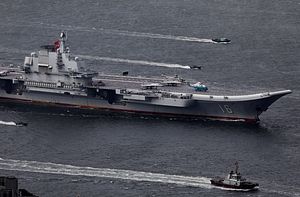The carrier strike group led by the People’s Liberation Army Navy’s (PLAN) sole operational aircraft carrier, the 60,000-ton Liaoning, a retrofitted Soviet-era Admiral Kuznetsov-class multirole aircraft carrier, has achieved initial operational capability, according to the Chinese Ministry of National Defense.
“The carrier group’s exercises have been deepened to include combat operations in the open seas. It has initially formed a system combat capability,” Ren Guoqiang, spokesperson of the Ministry of National Defense, said at a press conference on May 31. The carrier strike group’s “comprehensive system of offense and defense has been effectively tested,” he added.
Last week, PLAN pilots conducted night landings on the Liaoning with Shenyang J-15 multirole fighter jets, which the official China Daily hailed as a “huge leap towards gaining full combat capability.” As I noted repeatedly in the past, the aircraft carrier, commissioned in 2012, principally serves as a test platform for future Chinese naval aviation and carrier operations (See: “Next Stop South China Sea? China’s 1st Aircraft Carrier ‘Ready for Combat’”).
The Liaoning is fitted with an underpowered aircraft-launching system, a so-called ski-jump assisted Short Take-Off But Arrested Recovery (STOBAR) launch system, which somewhat reduces the carrier air wing’s operational range and strike power in comparison to aircraft stationed aboard U.S. carriers, which are launched with catapult assisted take-off but arrested recovery (CATOBAR) aircraft launch systems.
“CATOBAR aircraft launch systems put less strain on the airframe of planes during takeoff, reducing maintenance cost in the long run and also allow carrier-based aircraft to carry a heavier weapons payload,” I explained previously. “Furthermore, CATOBAR launch systems increase the sortie rates of carrier air wings by allowing a faster landing and takeoff rate.”
The Liaoning can reportedly carry an air wing of 24 Shenyang J-15s. The J-15 is a variant of the fourth-generation Sukhoi Su-33 twin-engine air superiority fighter jet. In addition, the carrier can accommodate up to 10 rotary wing aircraft, including Changshe Z-18, Ka-31, and Harbin Z-9 helicopters.
While the PLAN has not officially elaborated on the composition of its new carrier strike group, the Liaoning during past operations has been escorted by a Luyang III-class (Type 052D) guided-missile destroyer, a Luyang II-class (Type 052C) guided-missile destroyer, a Jiangkai II-class (Type 054A) guided-missile frigate, and alternatively one to two Yuan-class (Type 039A) or Song-class (Type 039) submarines.
Notably, the Liaoning strike group has repeatedly entered Taiwan’s air defense identification zone (ADIZ) over the last couple of months during training exercises. Meanwhile, the PLAN’s first domestically designed and built aircraft carrier, the Type 001A Shandong (CV-17), successfully completed its maiden sea trials in May.

































